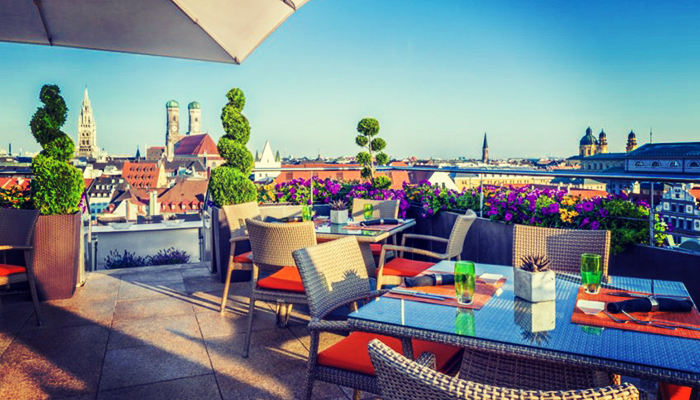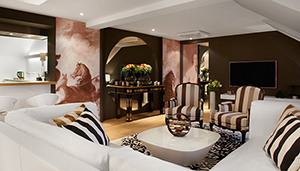Munich exudes Old World charm with its beautiful Gothic architecture, its cobblestone streets and a history that stretches back to 1158. But this old German city is seeing some new things happening—and they go beyond its famed Oktoberfest. After a recent visit to the historic city, our Forbes Travel Guide editors compiled a list of reasons why you should put Munich at the forefront of your travel itinerary:
Where To Stay
You might miss the city’s stalwart luxury hotel, Mandarin Oriental, Munich, which is discreetly tucked away on a small street off the upscale Maximilianstrasse shopping strip. But that won’t be the case soon; the elegant hotel, which was built in 1880 as an opera house, has big plans to expand. Mandarin Oriental will construct another building in the adjacent multistory parking lot and add 51 guest rooms (bringing the total to 124 rooms), 19 residences, a spa, stores, a gym, a pool and a restaurant and bar. Construction on the annex is scheduled to start in 2018. However, you’ll start to notice some changes sooner: The hotel will refurbish its existing 73 guest rooms, lobby, meeting space and Asian-influenced French eatery Restaurant Mark’s sometime around the end of this year.
For now, take advantage of the hotel’s best little-known perk: its rooftop, which changes with the season. Unfortunately, the charming Bavarian wooden chalet restaurant won’t be set up on the roof this winter due to some technical maintenance work. But China Moon Roof Terrace is open through October. Go there to swim in the guests-only heated pool or take a seat and nosh on international fare like the Asian glass noodle salad with king prawns while soaking up the all-encompassing view of the city and the mountains in the distance.
Just a short walk from Mandarin Oriental in an unbeatable location on Maximilianstrasse (Bulgari is next door and Hermès, Dior and Cartier are across the street), Hotel Vier Jahreszeiten Kempinski also pays respect to tradition with touches like the stained-glass dome ringed with warm browns, oranges and reds in the lobby and modern guest rooms wallpapered with photographs of European paintings from the city’s Alte Pinakothek museum (a Rubens or van Dyck may cover a stray wall or the ceiling above your bed). But one of the latest offerings from the artsy, modern hotel is its penthouse suite, which used to be the home of the property’s general manager. The more than 2,690-square-foot apartment (which can be split into two suites) is decorated like a French boudoir with a sleek black- and-white palette, Louis XVI-style furniture, glass tables and those photographed art accent walls. There’s also a white kitchen with Gaggenau appliances and a 678-square-foot terrace that overlooks central Munich.
For a change of scenery, try The Charles Hotel, which claims a quiet locale next to the Old Botanical Garden. One of the city’s newest hotels (it opened in 2007), The Charles peppers its spaces with German details, like art from 19th-century Munich painter Franz von Lenbach—the artist’s largest portrait collection is housed at the hotel—Bavarian limestone in the bathrooms and books such as Die Blechtrommel (The Tin Drum) in the guest rooms (Rocco Forte’s Frankfurt and Berlin hotels carry the same books, so you can continue reading in whichever city you land in next). To make the most of the summer, book the contemporary hotel’s picnic/bike tour. You’ll get a basket for two with Bavarian pretzels, fruit and more, plus a blanket, dishes and cutlery and a pair of Winora bicycles so you can pedal to a picnic spot. If your visit falls on the first Saturday of the month, check out the nighttime Italian Market at onsite restaurant Davvero. As you listen to live Italian music, stop at the various stations for housemade pasta cooked to order, prosciutto, wine and Italian desserts.
What to See
It may be tempting to spend all of your time in the bustling Marienplatz, the city’s main square, but there are a number of new attractions coming to Munich. One of the most important will be the opening of the Munich Documentation Centre for the History of National Socialism in April 2015. Housed in the former Nazi headquarters, the structure will be a six-story white modernist cube that is an intentional contrast to the buildings from that period. The educational center will examine the history of National Socialism in Munich, which Hitler called the “capital of the movement,” and the unfortunate legacy it left behind. For more contrast between that period and the city that Munich has become, check out the exhibitions at the Haus der Kunst by such contemporary artists as Stan Douglas (his “Mise en scène” runs through October 12) and Matthew Barney (whose “River of Fundament” is a multimedia event on display through August 17). Both artists use the museum’s space to juxtapose their own styles with the forbidding architecture of the museum itself, which was built in 1937 as an emblem of Nazi aesthetics. Tucked in the rear of the building is an excellent café, which maintains the garish, original wall depictions of a world under a global Reich, with golden maps of different continents given Germanic names.
On a lighter note, the theater scene is getting revitalized as well. The Gärtnerplatz Theater is undergoing renovations and plans to reopen in September 2015—which also marks its 150th anniversary—but in the meantime, its resident opera company is making use of other city stages, including those at Circus Krone (Munich’s grand circus), Cuvilliés Theater (the oldest theater in Munich), Prinzregententheater (originally built to be an opera house for Wagner works) and Reithalle (a former army hall). The new venues will make for some interesting performances. Debuting in 1896, the Deutsches Theater recently reopened after a five-year renovation and launched its new season in March. Catch the excellent Alvin Ailey American Dance Theater (through August 10) and Elisabeth (March 6-June 7, 2015), which continues to be the most well-known German musical of all time, depicting the doomed empress of Austria, who lived lavishly only to be assassinated in 1898.
If you’re more of an active traveler, you’ll want to try surfing in Munich’s Eisbach. While it’s not a new activity—surfers have been riding waves in this brook inside the English Garden for more than 35 years—it’s a hidden gem among locals and pro surfers. A small dam plus the brook’s abundant Isar River-fed water equals a standing wave that measures almost two feet high and about 40 feet wide. Surfers are an unexpected sight in the midst of the joggers, bicyclists and pedestrians in the park. And even if you don’t Hang 10, it’s fun to watch surfers line up and ride the wave in the relatively small brook year round. Of course, afterward you’ll want to partake in Munich’s preferred warm-weather activity: imbibing in a beer garden. The park’s 7,000-seat beer garden is the second largest in the city (behind Königlicher Hirschgarten) and among the world’s most famous. It’s not new, but the summer ritual proves that there’s something to be said for tradition.


















